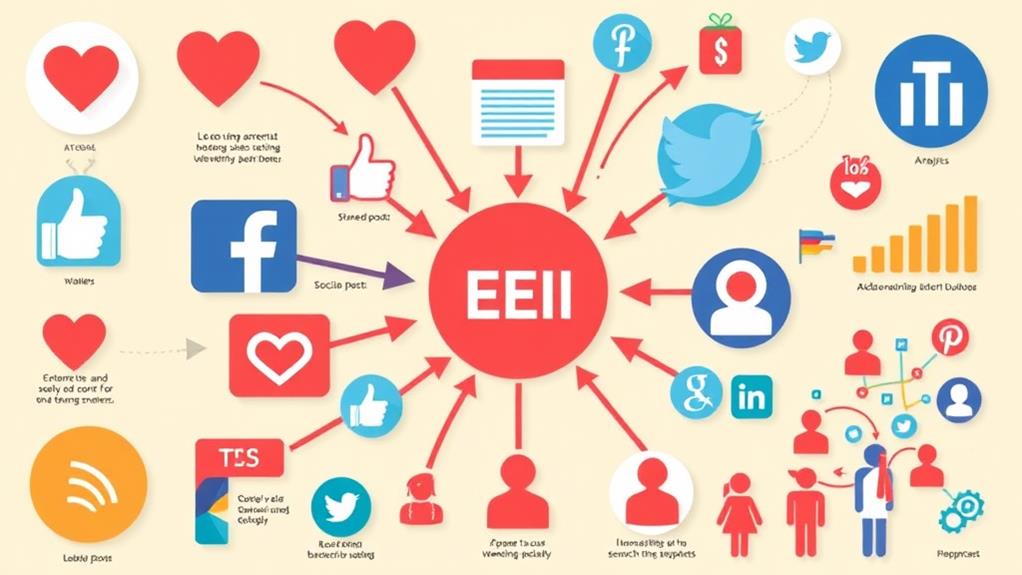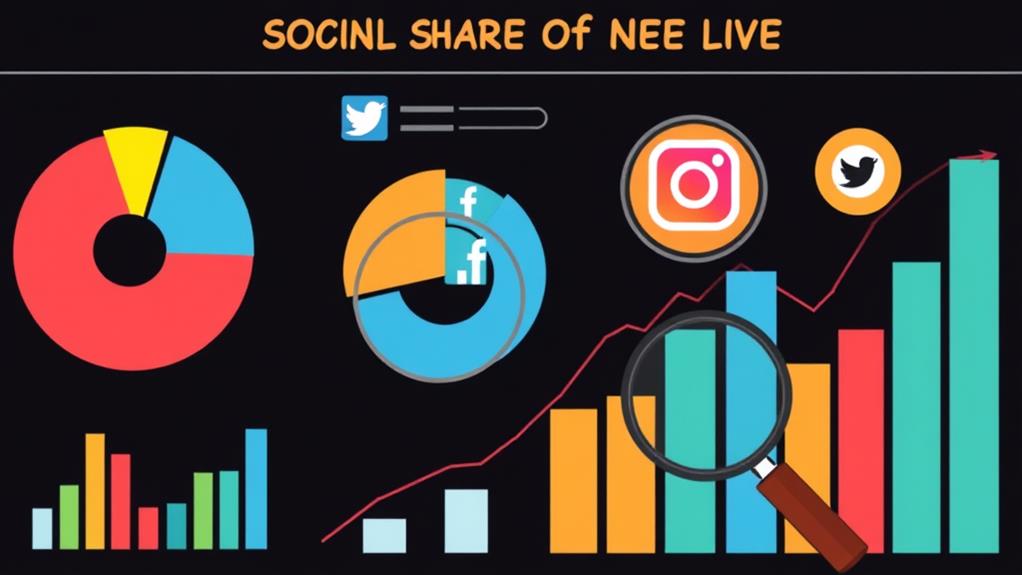To track and measure the success of your social media content, focus on metrics such as engagement (likes, comments, shares), reach, impressions, and conversions. Engage with audience interaction data to optimize visibility and enhance content strategies. Over 50% of business leaders utilize these metrics to align social media efforts with company objectives and ROI. Employ UTM parameters to link traffic directly to campaigns. Regular analysis of these metrics will identify strengths and areas of improvement, ensuring timely adjustments for sustained relevance. For a deeper understanding of how these metrics contribute to your overall strategy, continue exploring the detailed insights.
Key Takeaways
- Track engagement metrics like likes, comments, shares, and saves to gauge audience interaction and content resonance.
- Measure reach and impressions to understand the visibility and exposure of your content.
- Utilize conversion metrics to link social media activities with business objectives such as sign-ups and purchases.
- Analyze audience metrics to tailor content strategies based on demographics and behavior.
- Monitor sentiment metrics to assess audience feelings toward your brand through comments and mentions.
Understanding Social Media Metrics
Understanding social media metrics is vital for any brand aiming to optimize its digital presence and drive meaningful engagement. Social media analytics offer a thorough view of performance benchmarks that gauge the efficacy of content strategies.
Key engagement metrics, such as likes, comments, and shares, provide significant insights into how well content resonates with the audience. These interactions not only reflect the level of audience engagement but also influence a brand's visibility in social media feeds, thanks to platform algorithms that prioritize popular content. High engagement rates can also lead to a snowball effect, increasing the reach and impact of your content over time.
Conversion metrics are equally important, as they tie social media efforts directly to business objectives. Metrics like conversion rates and click-through rates (CTR) reveal the effectiveness of campaigns in driving desired actions, such as website visits or product purchases. By analyzing these data points, brands can refine their strategies to boost conversion rates.
Furthermore, audience metrics explore the demographic and behavioral characteristics of followers, enabling brands to tailor their messaging for better engagement. Understanding who the audience is and how they interact with content allows for more targeted, effective campaigns.
Why Tracking Metrics Matters
In the sphere of social media strategy, the importance of tracking metrics cannot be overstated. Success indicators derived from metric tools are crucial for making data-driven decisions that enhance the effectiveness of social media strategies. Over 50% of business leaders leverage social media insights to shape their company strategies, underscoring the critical role these metrics play in guiding organizational direction.
Twitter Analytics, for instance, helps track key metrics like impressions and engagement rates, which provide valuable insights into audience behavior and content performance.
Tracking metrics allows businesses to measure ROI from social media campaigns, providing a clear correlation between social media efforts and revenue outcomes. Regularly monitoring engagement metrics such as likes, shares, and comments offers actionable insights into audience preferences, enabling brands to refine their content strategies effectively.
Moreover, identifying strengths and weaknesses through these success indicators allows for timely adjustments to social media strategies. This guarantees that businesses can respond effectively to emerging trends and audience feedback, maintaining relevance and engagement in a dynamic digital landscape.
Key Metrics Categories
When evaluating social media performance, categorizing key metrics is essential for a thorough analysis. These categories provide a structured approach to understanding diverse aspects of social media success.
Engagement Metrics measure audience behavior and content relevance through likes, shares, comments, and saves. High engagement rates, often 1% or higher, indicate that the content resonates well with the audience, reflecting strong interest and relevance. Regular monitoring of engagement rates can inform strategic content adjustments to better align with audience preferences.
Reach and Impressions offer insights into brand visibility. Reach accounts for the number of unique users who see your content, while impressions measure how often the content is displayed, including multiple views by the same user. This distinction is vital for understanding overall exposure and potential audience saturation.
Conversion Metrics track specific actions, such as sign-ups or purchases, resulting from social media efforts. Conversion rates, calculated by dividing conversions by clicks, are pivotal in evaluating the effectiveness of campaigns and their ability to drive desired outcomes.
Audience Metrics focus on the demographics and behaviors of followers. Analyzing these metrics helps tailor content and messaging strategies, while follower growth rates indicate increasing brand interest and expanding reach.
Sentiment Metrics gauge audience feelings toward your brand through tools analyzing comments and mentions. This provides valuable insights for strategy adjustments based on public perception and brand reputation.
Engagement Metrics Breakdown
To effectively gauge the resonance of your content, it is essential to analyze key engagement metrics such as likes, comments, shares, and saves.
Calculating the engagement rate—by dividing total engagements by audience size and multiplying by 100—offers a clear metric of content effectiveness.
Monitoring audience engagement provides insights into how well your posts are performing and helps refine your content strategy.
Identifying patterns and trends in these interactions provides actionable insights for enhancing audience engagement strategies.
Types of Engagement Metrics
Tracking Social Media Success
Types of Engagement Metrics
Breaking down engagement metrics provides a thorough understanding of how audiences interact with social media content. Analyzing different engagement types, such as likes, comments, shares, and saves, is essential for determining the metric importance in social media strategy. Each engagement type offers unique insights into how content resonates with the audience.
| Engagement Type | Importance |
|---|---|
| Likes | Indicates immediate approval and popularity of content. |
| Comments | Offers qualitative insights into audience sentiment and feedback. |
| Shares | Reflects strong content approval and emotional connection, extending reach. |
| Saves | Demonstrates content's lasting value and relevance to the audience. |
Likes are the simplest form of engagement, highlighting content's immediate appeal. Comments offer a deeper level of interaction, providing valuable feedback and sentiment analysis. Tracking shares is particularly significant, as it signifies strong audience approval and drives further reach and visibility. Saves indicate that the content has lasting value and relevance, suggesting it is worth revisiting.
Calculating Engagement Rates
Calculating engagement rates is a fundamental step in measuring the effectiveness of social media campaigns and understanding audience interaction. Engagement rates are determined by dividing the total interactions—such as likes, comments, and shares—by the total number of followers for organic campaigns or total views for paid campaigns, then multiplying by 100 to express it as a percentage. This metric provides a clear picture of how well content resonates with the audience.
Engagement benchmarks typically sit at around 1% or higher. Exceeding this threshold often signifies a successful campaign and a robust connection with the audience. High engagement rates not only indicate content relevance but also enhance visibility in social media feeds, as algorithms prioritize posts with higher interaction levels.
Analyzing engagement uplift involves comparing current campaign rates with historical data, offering insights into effective content strategies and areas needing improvement. Audience segmentation further refines this analysis by revealing how different audience groups interact with content, thereby guiding targeted strategies.
Utilizing tools such as free engagement rate calculators can streamline the tracking process, ensuring accurate and efficient measurement across various platforms. This data-driven approach is essential for optimizing social media performance and achieving sustained success.
Boosting Audience Interaction
Boosting audience interaction is essential for achieving sustained social media success, as engagement metrics like likes, comments, shares, and saves offer valuable insights into how well your content resonates with your audience.
Engagement metrics serve as critical indicators of interaction quality, with a benchmark engagement rate above 1% typically indicating successful campaigns. By tracking likes and shares over time, you can uncover trends in audience sentiment and content approval, pinpointing which posts resonate most with your followers.
Comments provide even deeper insights into audience interaction. Encouraging thoughtful responses can greatly foster community engagement and yield valuable audience feedback. This qualitative feedback is instrumental in refining your interaction strategies and enhancing content relevancy.
The engagement rate, calculated as (Total engagements / Total followers) x 100%, offers a precise measurement of content performance relative to your audience size.
Utilizing analytics tools to monitor these metrics can reveal which content strategies drive higher interaction rates. These insights not only inform future content creation but also guarantee that your social media efforts are aligned with audience preferences, thereby boosting overall engagement and achieving sustainable social media success.
Calculating Engagement Rate

Understanding how to quantify social media performance is vital, and engagement rate serves as a key metric in this evaluation. Engagement rate is calculated by dividing the total number of interactions—comprising likes, comments, and shares—by the total number of followers (for organic posts) or total impressions (for paid posts). This result is then multiplied by 100 to express it as a percentage.
Engagement benchmarks can vary considerably across different social media platforms and industries. Typically, an engagement rate of 1% or higher is regarded as successful, indicating that the content resonates well with the audience. However, it is essential to take into account audience demographics, as engagement rates may differ depending on the age, location, and interests of the followers.
Additionally, analyzing engagement patterns and peak activity times can provide deeper insights into when your audience is most active, further enhancing your strategy.
Tracking engagement rate over time provides valuable insights into content performance. High engagement rates not only reflect strong audience connection but also boost post visibility due to social media algorithms favoring engaging content.
Analyzing Likes and Comments
Analyzing likes and comments is essential for understanding audience engagement and sentiment towards your social media content.
By tracking like trends over time, businesses can identify growth patterns and adjust their strategies accordingly. Additionally, high likes and retweets indicate strong audience interaction with content.
Evaluating the quality of comments provides nuanced insights into audience interaction and feedback. This dual approach not only enhances content relevance but also leverages algorithm preferences to boost overall visibility.
Measuring Like Trends
Consistently monitoring likes over time is essential for identifying growth trends and understanding which content resonates most with your audience. By analyzing like frequency, you can discern growth patterns and pinpoint content resonance. This process involves tracking the number of likes each post receives, which aids in recognizing audience preferences and making strategic adjustments to your content strategy.
Trend identification becomes more manageable when you regularly conduct post comparisons. This practice highlights which types of posts generate interaction spikes, revealing key engagement drivers. Additionally, examining seasonal variations in likes can offer insights into how different times of the year affect audience behavior and preferences.
Data-driven analysis of like trends not only helps in recognizing content that performs well but also in identifying posts that underperform. By understanding these dynamics, you can refine your approach, ensuring future content aligns more closely with audience interests.
Moreover, pinpointing consistent patterns in audience engagement allows for better prediction and planning, ultimately driving a more effective and responsive content strategy.
Analyzing Comment Quality
Shifting focus from the patterns of likes, another essential aspect for evaluating social media success is the quality of comments. Analyzing comment quality involves delving beyond mere numbers to assess the depth and meaning of interactions. Meaningful comments often indicate higher audience investment and engagement, providing considerable audience feedback.
Monitoring comment trends over time can shed light on content relevance and audience interest. By examining the frequency and nature of comments, brands can identify what resonates most with their followers, making data-driven adjustments to their engagement strategies.
Engaging with comments by asking questions or prompting discussions can markedly enhance interaction depth. This approach encourages more meaningful discussions and valuable feedback, which are critical for fine-tuning future content creation strategies and understanding brand perception.
Additionally, tracking comment sentiment—whether positive, negative, or neutral—offers insights into overall audience feelings towards the brand. This information is essential for guiding messaging adjustments and strategic pivots.
- Assess comment sentiment to gauge audience feelings.
- Monitor comment trends to understand content relevance.
- Engage in meaningful discussions to deepen interaction.
- Use audience feedback to refine engagement strategies.

Content shares serve as a vital metric in the domain of social media marketing, providing a quantifiable measure of audience approval and engagement. High share frequency often indicates content that resonates deeply with users, driven by emotional resonance and relevance to audience demographics.
Analyzing which content types and formats garner the most shares can reveal valuable insights into what your audience finds compelling. For example, campaigns like those by Warby Parker have shown that relatable, everyday scenarios can greatly boost engagement and shares.
Different share platforms have varying impacts on share frequency and viral potential. For instance, visual content might perform better on Instagram, while thought-provoking articles might see higher shares on LinkedIn. Understanding these platform-specific trends enables more targeted content creation.
Timing strategies also play an essential role. Content shared during peak activity times can exponentially increase its reach, exposing it to new audiences and attracting non-followers.
Monitoring how share frequency varies with timing can inform best posting schedules.
Reach and Impressions Insights
Understanding the metrics of reach and impressions is fundamental for any thorough social media strategy. Reach refers to the total number of unique users who see your content, providing insight into your brand's potential audience size.
Impressions, on the other hand, indicate how many times your content is displayed, which can often exceed reach due to repeated views by the same user. Monitoring these metrics is essential for evaluating content visibility and effectiveness.
Differentiating between follower reach and non-follower reach allows for an all-encompassing understanding of how well your content extends beyond your immediate audience. This distinction is important for gauging broader audience exposure and developing effective engagement strategies.
Tracking reach trends and conducting impression analysis over time can reveal patterns that inform future content strategies. For instance, a higher reach with lower impressions might indicate a need for more engaging content.
Additionally, analyzing audience engagement tendencies can help optimize your content strategy, ensuring that it resonates with viewers.
- Follower Reach: Understanding visibility within your follower base.
- Non-Follower Reach: Measuring exposure beyond followers.
- Reach Trends: Observing fluctuations in reach over time.
- Impression Analysis: Evaluating the frequency of content displays.

In the competitive landscape of social media marketing, measuring Social Share of Voice (SSoV) is essential for understanding a brand's visibility relative to its competitors. SSoV quantifies the percentage of brand mentions within social media conversations, providing insight into market presence and brand advocacy. Tracking this metric allows brands to see their portion of the overall industry conversation, facilitating a clear competitor comparison.
Utilizing tools like Brandwatch and Mention, marketers can effectively monitor SSoV, capturing sentiment analysis around brand mentions. This data-driven approach not only highlights visibility but also informs strategic adjustments and enhances consumer trust and engagement. A higher SSoV signifies stronger brand advocacy, often correlating with increased consumer interaction and loyalty.
Detailed performance insights from influencer campaigns can also help to refine SSoV metrics, ensuring that the brand remains relevant and engaging in the social media landscape.
Regular analysis of SSoV data reveals emerging trends and shifts in audience perception, enabling brands to fine-tune their messaging and positioning in real-time. By consistently evaluating their SSoV, companies can stay ahead of industry trends and maintain a competitive edge.
Ultimately, SSoV is a critical metric for evaluating brand health and ensuring that a brand remains prominent in the crowded social media space.
Conversion Metrics Analysis
Evaluating the effectiveness of social media efforts hinges on a thorough analysis of conversion metrics, which serve as critical indicators of campaign success. Key metrics such as conversion rate, Click-Through Rate (CTR), Cost-Per-Click (CPC), and Cost Per Thousand Impressions (CPM) provide invaluable insights into the conversion funnel and user behavior.
For small businesses, TikTok's cost-effective advertising options make it easier to monitor these metrics without overspending.
The conversion rate quantifies success by dividing the number of conversions by total clicks and multiplying by 100, offering a direct measure of how effectively social media activities translate into desired actions.
CTR, calculated by dividing clicks by impressions and multiplying by 100, reveals how engaging the content is and how well it drives traffic.
CPC, derived from dividing total ad spend by clicks, aids in budget optimization by pinpointing the exact cost of user engagement.
CPM, representing the cost of reaching a thousand potential customers, evaluates the reach and exposure effectiveness of ads.
- Conversion Rate: Measures effectiveness of converting clicks into actions.
- Click-Through Rate (CTR): Assesses audience engagement with content.
- Cost-Per-Click (CPC): Optimizes budget by evaluating cost per engagement.
- Cost Per Thousand Impressions (CPM): Analyzes ad reach and exposure.
Incorporating UTM parameters into tracking allows businesses to link social media activities directly to traffic and sales, ensuring alignment with business objectives and maximizing ROI.
Frequently Asked Questions
How to Measure Success of Social Media Content?
To measure success, analyze engagement metrics by calculating the engagement rate, track audience growth by monitoring follower count, and evaluate reach and impressions. Additionally, assess conversion metrics and utilize sentiment analysis to gauge audience sentiment effectively.
How to Track Social Media Results?
Track social media results by leveraging analytics tools to monitor engagement metrics such as likes, shares, and comments. Additionally, assess audience growth by analyzing follower count changes before and after campaigns, providing a thorough view of your strategy's effectiveness.
How Do You Measure the Success of Your Content Efforts?
To measure the success of your content efforts, evaluate content engagement through interaction rates, track audience growth via follower metrics, and utilize conversion rates. Employ social media analytics tools to analyze reach, impressions, and sentiment for thorough insights.
How to Evaluate the Effectiveness of Social Media?
To evaluate the effectiveness of social media, consider engagement metrics and audience insights. Track likes, shares, and comments to assess interaction, while demographic analysis and sentiment analysis provide a thorough understanding of audience engagement and content impact.
Conclusion
In conclusion, the systematic tracking and measurement of social media content success are imperative for optimizing digital marketing strategies. By thoroughly understanding metrics such as engagement rates, content shares, reach, impressions, social share of voice, and conversion rates, organizations can make data-driven decisions that enhance content performance and audience engagement. An analytical approach to these metrics offers valuable insights into the effectiveness of social media efforts and informs future content development and strategic planning.




